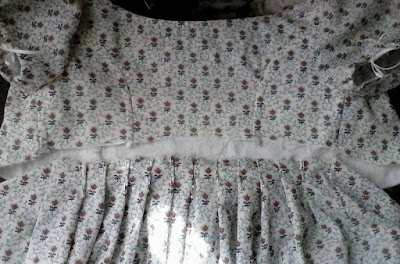The
Sense and Sensibility pattern for a girls regency dress is one I have used a
lot. Its basic form is classically regency with a high waisted, fitted bodice and a moderately full skirt. There are short puff sleeves or long sleeves to choose from. The gown is back fastening with buttons.

While I do like the original style of the pattern, it's always fun to change things up a bit and see what other styles you can create. I have found that the girls regency dress pattern makes a terrific "pattern block" from which you can create a ton of different styles. One of my current projects is creating a regency era dress for the daughter of a friend and I thought I'd document how to alter this basic pattern to make a dress that is fitted with drawstrings. (The original pattern includes fabulous directions on how to make a drawstring-look dress using elastics. This dress uses ribbon and twill tape to get the gathered look.) Gathered dresses are perfect for garments that are meant to be used by rapidly growing kids and since the sizing is so adjustable its great if you plan to eventually hand the garment down to a different child. It's not quite one size fits all, but it's close!
Cutting the dress is only a little different. The back bodice has the center back line placed on the fold. This makes a one-piece center back. The side backs are cut as usual. The front bodice is cut placing the center front line about 2"-4" from the fold (depending on how full you want the gathers to be). The sleeves are cut as usual. For the skirt, I cut two rectangles as long as my desired waist-to-hem measurement + 2" for seam allowance and a narrow hem and as wide as the fabric, usually. The back skirt remains a rectangle and the front skirt is slightly shaped into an A-line, with the top edge of the skirt equaling the bottom edge of the front bodice.
The bodice is sewn together. For this dress I cut a lining of white cotton and treated it as one with the outer layer. To finish the seams I turned under the seam allowance and slip stitched it down. This creates a nice firm finish to give a little structure to the dress.
You can see the extra width in the front bodice. The neckline is narrowly hemmed by hand. The sleeves are set in as usual.
For these sleeves, I narrowly hemmed the bottom edge and ran a tape through the hem so that they are adjustable. It also makes ironing a lot easier!
The skirt is seamed together at the sides. I used french seams for this skirt. I don't think that French seams are very common on original gowns but it makes a good strong finish and is quicker than finishing the seams by hand. The back skirt is pleated to fit the back bodice:
Matching side seams, the skirt is pinned and sewn to the bodice, right sides together.
Two tiny buttonholes are worked just above the waist seam and right next to the side seam on the front bodice.
And an eyelet worked in the hem of the neckline at center front.
To make the casing for the waist drawstring, the seam allowance is turned up towards the bodice, the raw edge folded over and slip stitched down.
The seam allowance between the skirt and back bodice can be finished in a variety of ways. For this dress I just turned under the seam allowance and slip stitched it down. For a heavier fabric this may be too bulky. If that's the case I will usually just bind the seam.
After the skirt hem is done, all that is left is to put in the drawstrings! I used cotton twill tape in the neckline and a ribbon in the waist. The waistline drawstring goes into the casing via the buttonholes, so that the ribbons come out at the sides and tie at the back.
Draw up the strings to fit and that is it!














































